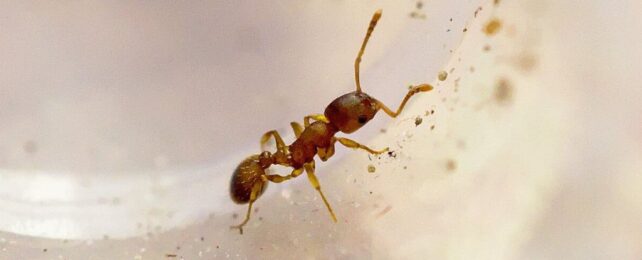Hosting a parasitic tapeworm isn't usually a desirable state. But the life of an infected ant known as Temnothorax nylanderi hits differently.
Suppose an ant of this species nibbles on some woodpecker poop as a young larva and contracts a tapeworm (Anomotaenia brevis). It could end up living three times longer than its peers, if not more, and it will rarely have to move a mandible.
Uninfected ants will do the worker's chores, carry it around, feed it, and groom it for the rest of its days. These pampered ants barely leave the nest.
A team of researchers led by entomologist Susanne Foitzik at the Johannes Gutenberg University in Germany has now figured out a possible explanation for this strangely idyllic lifestyle.
When a tapeworm sets up shop in the gut of an ant, it appears to pump antioxidants and other proteins into the creature's bloodstream.
It's still unclear what health effects these special proteins have, but there's a real chance they are part of what helps infected ants stay young and yummy.
In the Anomotaenia tapeworm's life cycle, an ant is not its final home. Its adult reproductive state takes place in the body of a woodpecker, which means the parasite has a vested interest in keeping its temporary host young, plump, and scrumptious-looking. That way, it might become a bird's breakfast once it grows up.
What happens to the ant colony is not the parasite's concern, so long as the infected ants survive until a woodpecker arrives.
In 2021, Foitzik and some of her other colleagues in Germany discovered that while Temnothorax ants infected with tapeworms lived a cushy life, the uninfected in a colony paid for the laziness of their peers.
These worker ants, now burdened with looking after their infected peers, died much, much earlier. And although neither the infected ants nor their attentive carers appeared to show any physiological indicators of stress, workers gave their queens less loving care as they tended to the infected, which may spell trouble for the colony.
Since the infected ants looked so youthful, the researchers were still curious to figure out what could be helping them live longer.
In their new study, which is yet to be peer-reviewed, researchers again compared infected and uninfected ants, this time looking at protein levels in the ants' hemolymph (the equivalent of an invertebrate's bloodstream).
They found that a tapeworm's proteins accounted for a "substantial portion" of those flowing through an individual's hemolymph, and two of the most abundant were antioxidants.
Some other proteins could explain why infected ants are treated like royalty – though many were unrecognizable, having no known equivalent in other organisms.
One protein called vitellogenin-like A found at high levels in infected individuals is not produced by the parasite but by the ant itself. It is known to regulate divisions of labor and reproduction in ant societies.
As a result, researchers think this protein might somehow influence the behavior of ants in a way that tricks others into doting on them.
What's still unclear is whether the tapeworm is actively manipulating the gene expression of ant proteins like vitellogenin-like A or if it is an accidental by-product of the parasitic infection.
"Since caste differences in social insects are usually not due to genetic differences, but controlled by differential gene expression, hijacking pre-existing regulatory pathways that make an individual more queen-like might be an elegant strategy from the parasite's point of view," Foitzik and colleagues point out.
Nevertheless, proving that a parasite is manipulating an ant body as opposed to an ant body acting in response to an invader would be incredibly difficult, if not impossible; the authors say this potential pathway of manipulation should be interpreted with caution.
The team in Germany plans to continue studying the parasite's proteins to better understand how they might influence ant behavior, appearance, and longevity.
The study was posted to the preprint server bioRxiv ahead of peer review.
